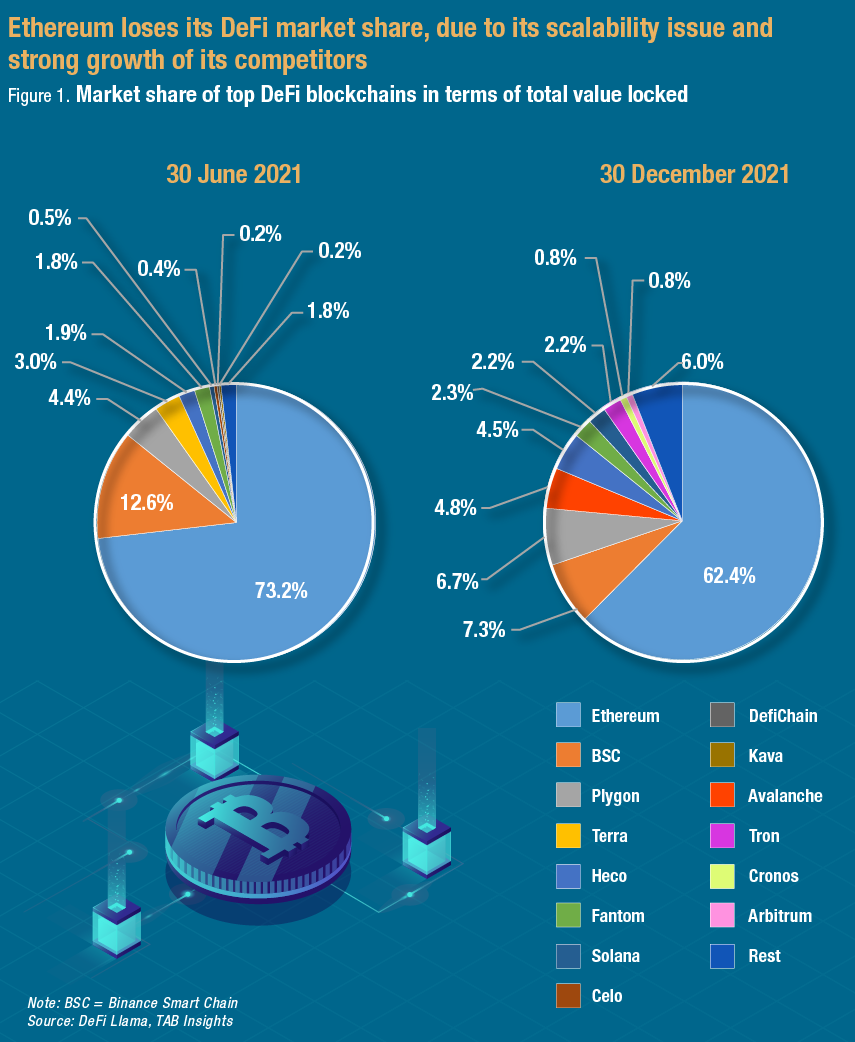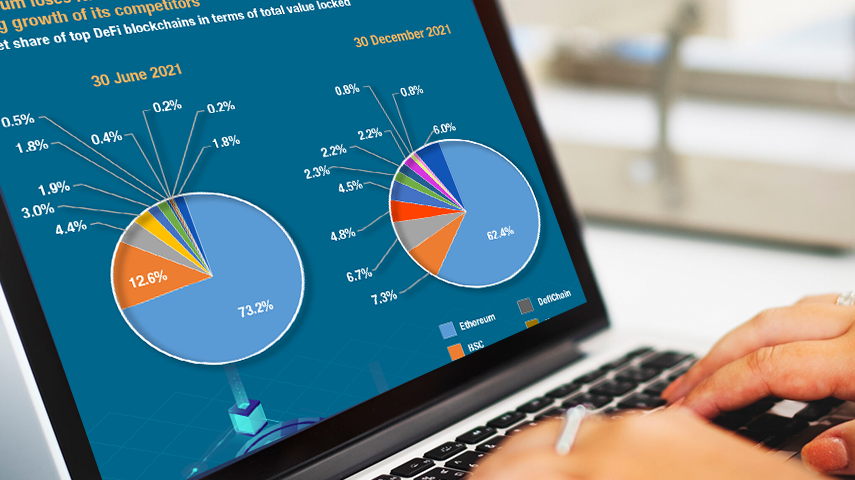- Ethereum lost its DeFi market share due to its scalability issue and strong growth of its competitors
- Total value locked in DeFi on Terra surged and it has become the second largest DeFi blockchain
- Binance Smart Chain has registered shower growth as it faces several challenges
More decentralized finance (DeFi) protocols have been launched, which provides various DeFi products and services, such as lending, borrowing, derivatives, exchanges, and insurance. The total value locked (TVL) in DeFi protocols rose sharply to $245 billion on 30 December 2021 from $19 billion at the end of 2020, according to DeFi Llama. TVL is the most common metric used to measure the size of the DeFi market. Despite the significant growth in TVL and higher rate of adoption among users, it is still small compared to traditional financial systems.
The top ten largest blockchain networks for DeFi protocols accounted for 94% of all DeFi activity. Ethereum continues to dominate the DeFi space, with 62.4% of the aggregate TVL in DeFi on 30 December 2021. Terra overtook Binance Smart Chain (BSC) to become the second largest DeFi blockchain on 20 December 2021. The combined market share of Ethereum, Terra and BSC leaves the rest of the market with 23.5% of TVL shared among 83 DeFi blockchain networks. Avalanche, Solana, Fantom and Polygon are among the top 10 largest DeFi blockchains.

Ethereum’s market share in DeFi TVL dropped
Although Ethereum is still the leading DeFi blockchain network, its share of the combined DeFi TVL declined significantly. It had a 97% share at the end of 2020, compared to 73.2% at the end of June 2021 and 62.4% on 30 December 2021. It faces tough competition, as more DeFi blockchain networks have emerged. The lack of scalability, slow processing speeds and high transaction fees continue to be a problem for Ethereum. Ethereum has been making efforts to address the issues, such as the deployment of Ethereum's London hard fork and Ethereum Improvement Proposal 1559 (EIP-1559) in August 2021, which changed Ethereum's transaction fee system.
Ethereum is moving to Ethereum 2.0 (ETH 2.0) in phases, with Beacon Chain, the first phase of ETH 2.0, being launched in December 2020. ETH 2.0 is an upgrade to the existing Ethereum blockchain, which includes a transition from Proof-of-Work to Proof-of-Stake. The long-delayed upgrade is expected to enhance the scalability and security of the Ethereum network. According to Ethereum co-founder Vitalik Buterin, Ethereum can potentially process up to 100,000 transactions per second, compared to the current 15 to 45 transactions per second. Meanwhile, the Ethereum Foundation estimates that ETH 2.0 will cut the power consumption by 99.95%.
On 20 December 2021, Ethereum announced that the Kintsugi Merge Testnet was live. This ETH 2.0’s longer-lived public testnet enables the community to experiment with post-merge Ethereum. It is expected that the Ethereum mainnet will merge with the Beacon Chain in the first half of 2022 and the Proof-of-Work mechanism will be officially replaced with the Proof-of-Stake.
DeFi Value on Terra Surged
On Terra, a blockchain payment network of decentralized stablecoins, 14 projects locked $18 billion in value on 30 December 2021, while Ethereum had $153 billion locked on 376 protocols and BSC had $16.4 billion locked on 254 protocols. On average, every protocol on Terra held $1.3 billion in value, compared with an average of $406 million per protocol on Ethereum and $64 million per protocol on BSC.
Terra’s DeFi market share stood at only 3% at the end of June 2021, when the TVL on its DeFi protocols was $3.4 billion. Its TVL reached an all-time high of $21.1 billion on 27 December 2021, up by 122% within a month. This coincided with the rising price of its native token LUNA, which was one of the best performing DeFi tokens in 2021. Anchor, a savings protocol offering low-volatile yields on Terra stablecoin deposits, maintains the highest dominance on the Terra network with 47% of its TVL. Anchor users deposit UST into the Anchor protocol and expect to earn an annual percentage yield of 20%. Anchor’s TVL gained 123% from 27 November 2021 to 27 December 2021. The TVL of Lido and Terraswap, the Terra’s second and fifth largest protocols, also moved up by 43% and 142% respectively during the same period.
Binance Smart Chain faces several challenges
BSC’s TVL in DeFi was less than $1 billion in early February 2021 and rose significantly to its all-time high of $31.7 billion on 10 May 2021. However, its TVL plummeted by 63% from 10 May 2021 to 23 May 2021. PancakeSwap and Venus, the top two largest protocols on BSC, saw the TVL drop by 64% and 68% respectively during this period. Since then, BSC has registered much slower growth in DeFi TVL than other DeFi blockchain networks. In the past six months, the TVL in DeFi on Terra and Ethereum jumped by 425% and 85%, respectively, while BSC only gained 16% in TVL.
Launched in September 2020, BSC employs a Proof of Staked Authority consensus mechanism to offer faster and cheaper transactions, which has attracted projects and users to its ecosystem. It has handled more transactions than other DeFi blockchains. The cumulative number of transactions on BSC has surpassed 1.5 billion transactions in just 14 months since its launch. However, its centralised nature has raised trust concerns, as it only has 21 validators. In addition, protocols on BSC have suffered a growing number of “rug pulls” or exploits, which has also raised concerns about its security.

































